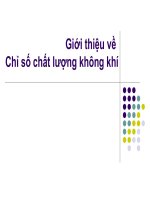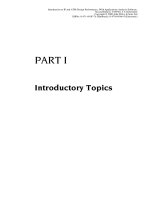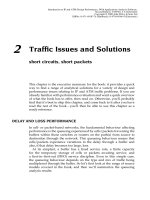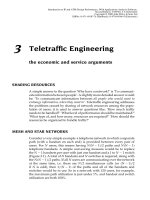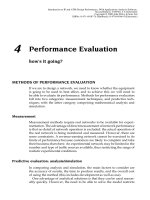Tài liệu Giới thiệu về IP và ATM - Thiết kế và hiệu suất P4 doc
Bạn đang xem bản rút gọn của tài liệu. Xem và tải ngay bản đầy đủ của tài liệu tại đây (100.47 KB, 12 trang )
4
Performance Evaluation
how’s it going?
METHODS OF PERFORMANCE EVALUATION
If we are to design a network, we need to know whether the equipment
is going to be used to best effect, and to achieve this we will need to
be able to evaluate its performance. Methods for performance evaluation
fall into two categories: measurement techniques, and predictive tech-
niques; with the latter category comprising mathematical analysis and
simulation.
Measurement
Measurement methods require real networks to be available for experi-
mentation. The advantage of direct measurement of network performance
is that no detail of network operation is excluded: the actual operation of
the real network is being monitored and measured. However, there are
some constraints. A revenue-earning network cannot be exercised to its
limits of performance because customers are likely to complain and take
their business elsewhere. An experimental network may be limited in the
number and type of traffic sources available, thus restricting the range of
realistic experimental conditions.
Predictive evaluation: analysis/simulation
In comparing analysis and simulation, the main factors to consider are
the accuracy of results, the time to produce results, and the overall cost
of using the method (this includes development as well as use).
One advantage of analytical solutions is that they can be used reason-
ably quickly. However, the need to be able to solve the model restricts
Introduction to IP and ATM Design Performance: With Applications Analysis Software,
Second Edition. J M Pitts, J A Schormans
Copyright © 2000 John Wiley & Sons Ltd
ISBNs: 0-471-49187-X (Hardback); 0-470-84166-4 (Electronic)
58
PERFORMANCE EVALUATION
the range of system or traffic characteristics that can be included. This
can result in right answers to the wrong problem, if the model has to
be changed so much from reality to make it tractable. Thus analysis is
often used to produce an approximation of a system, with results being
produced relatively quickly and cheaply.
Networks of almost arbitrary complexity can be investigated using
simulation: systems may be modelled to the required level of precision.
Very often, simulation is the only feasible method because of the nature
of the problem and because analytical techniques become too difficult to
handle. However, simulation can be costly to develop and run, and it is
time-consuming, particularly when very rare events (such as ATM cell
loss) are being measured (although accelerated simulation techniques
can reduce the time and cost involved).
QUEUEING THEORY
Analysis of the queueing process is a fundamental part of performance
evaluation, because queues (or ‘waiting lines’) form in telecommuni-
cations systems whenever customers contend for limited resources. In
technologies such as ATM or IP not only do connections contest, and
may be made to queue, but each accepted connection consists of a stream
of cells or packets and these also must queue at the switching nodes or
routers as they traverse the network.
We will use a queue then as a mathematical expression of the idea of
resource contention (Figure 4.1): customers arrive at a queueing system
needing a certain amount of service; they wait for service, if it is not
immediately available, in a storage area (called a ‘buffer’, ‘queue’, or
‘waiting line’); and having waited a certain length of time, they are
served and leave the system. Note that the term ‘customers’ is the general
expression you will encounter in queueing theory terminology and it is
Buffer Server
q, number of customers in system
w, number of
customers waiting
r
, utilization
Customers
arriving
with rate
λ
t
w
, waiting time
t
q
, system time
s, service time
Customers
leaving
Figure 4.1. The Queueing System
QUEUEING THEORY
59
used to mean ‘anything that queues’;inATMorIP,thecustomerscanbe
cells, packets, bursts, flows, or connections. In the rest of this chapter, the
queueing systems refer to ATM buffers and the customers are cells.
Any queueing system is described by the arrival pattern of customers,
the service pattern of customers, the number of service channels, and
the system capacity. The arrival pattern of customers is the input to
a queueing system and can sometimes be specified just as the average
number of arrivals per unit of time (mean arrival rate, ) or by the average
time between arrivals (mean inter-arrival time). The simplest input any
queueing system can have is ‘deterministic’, in which the arrival pattern
is one customer every t time units, i.e. an arrival rate of 1/t.So,fora
64 kbit/s constant bit-rate (CBR) service, if all 48 octets of the information
field are filled then the cell rate is 167 cell/s, and the inter-arrival time
is 6 ms. If the arrival pattern is ‘stochastic’ (i.e. it varies in some random
fashion over time), then further characterization is required, e.g. the
probability distribution of the time between arrivals. Arrivals may come
in batches instead of singly, and the size of these batches may vary. We
will look at a selection of arrival patterns in Chapter 6.
The service pattern of customers, as with arrival patterns, can be
described as either a rate, , of serving customers, or as the time, s,
required to service a customer. There is one important difference: service
time or service rate are conditioned on the system not being empty. If it is
empty, the service facility is said to be ‘idle’. However, when an ATM cell
buffer is empty, a continuous stream of empty cell slots is transmitted.
Thus the server is synchronized and deterministic; this is illustrated in
Figure 1.4
In the mathematical analysis of an ATM buffer, the synchronization is
often neglected – thus a cell is assumed to enter service immediately upon
entry to an empty buffer, instead of waiting until the beginning of the
next free slot. For a 155.52 Mbit/s link, the cell slot rate is 366 792 cell/s
and the service time per cell is 2.726
µ
s. However, 1 in every 27 cell slots is
used for operations and maintenance (OAM) cells for various monitoring
and measurement duties. Thus the cell slot rate available for trafficis
26
27
Ð 366 792 D 353 208 cell/s
which can be approximated as a service time per cell of 2.831
µ
s.
The number of service channels refers to the number of servers that
can serve customers simultaneously. Multi-channel systems may differ
according to the organization of the queue(s): each server may have its
own queue, or there may be only one queue for all the servers. This is of
particular interest when analysing different ATM switch designs.
The system capacity consists of the waiting area and the number of
service channels, and may be finite or infinite. Obviously in a real system
60
PERFORMANCE EVALUATION
the capacity must be finite. However, assuming infinite capacity can
simplify the analysis and still be of value in describing ATM queueing
behaviour.
Notation
Kendall’snotation,A/B/X/Y/Z, is widely used to describe queueing
systems:
A specifies the inter-arrival time distribution
B specifies the service time distribution
X specifies the number of service channels
Y specifies the system capacity, and
Z specifies the queue discipline
An example is the M/D/1 queue. Here the ‘M’ refers to a memoryless,
or Markov, process, i.e. negative exponential inter-arrival times. The ‘D’
means that the service time is always the same: fixed or ‘deterministic’
(hence the D), and ‘1’ refers to a single server. The Y/Z part of the notation
is omitted when the system capacity is infinite and the queue discipline is
first-come first-served. We will introduce abbreviations for other arrival
and service processes as we need them.
Elementary relationships
Table 4.1 summarizes the notation commonly used for the various
elements of a queueing process. This notation is not standardized, so
beware... for example, q may be used, either to mean the average
number of customers in the system, or the average number waiting to
be served (unless otherwise stated, we will use it to mean the average
number in the system).
There are some basic queueing relationships which are true, assuming
that the system capacity is infinite, but regardless of the arrival or service
Table 4.1. Commonly Used Notation for Queueing Systems
Notation Description
mean number of arrivals per unit time
s mean service time for each customer
utilization; fraction of time the server is busy
q mean number of customers in the system (waiting or being served)
t
q
mean time a customer spends in the system
w mean number of customers waiting to be served
t
w
mean time a customer spends waiting for service
QUEUEING THEORY
61
patterns and the number of channels or the queue discipline. The utiliza-
tion, , is equal to the product of the mean arrival rate and the mean
service time, i.e.
D Ð s
for a single-server queue. With one thousand 64 kbit/s CBR sources, the
arrival rate is 166 667 cell/s. We have calculated that the service time of a
cell is 2.831
µ
s, so the utilization, , is 0.472.
The mean number of customers in the queue is related to the average
time spent waiting in the queue by a formula called Little’s formula (often
written as L D Ð W). In our notation this is:
w D Ð t
w
So, if the mean waiting time is 50
µ
s, then the average queue length
is 8.333 cells. This relationship also applies to the average number of
customers in the system:
q D Ð t
q
The mean time in the system is simply equal to the sum of the mean
service time and waiting time, i.e.
t
q
D t
w
C s
which, in our example, gives a value of 52.831
µ
s. The mean number of
customers in a single-server system is given by
q D w C
which gives a value of 8.805 cells.
The M/M/1 queue
We can continue with the example of N CBR sources feeding an ATM
buffer by making two assumptions, but the example will at least give us
a context for choosing various parameter values. The first assumption is
that the cell arrival pattern from N CBR sources can be approximated by
negative exponential inter-arrival times. This is the same as saying that
the arrivals are described by a Poisson process. This process just looks at
the arrival pattern from a different perspective. Instead of specifying a
time duration, the Poisson distribution counts the number of arrivals in
a time interval.
The second assumption is that the service times of these cells are
described by a negative exponential distribution. In Chapter 8 we will
see that the first assumption can be justified for large N. Given the fact
that ATM uses fixed-length cells (and hence fixed service times), the


